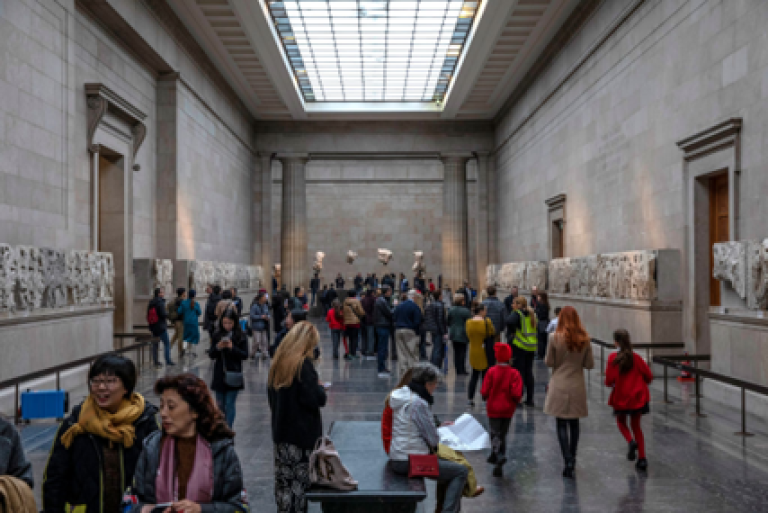Infamously housed in a bright and airy hall in London’s British Museum, the Elgin marbles are photographed and viewed by millions of visitors each year. In recent years, the Elgin name has become synonymous with the debate of art repatriation – the process by which art and artifacts are returned to their country of origin at the request of a government. Taken from the roof of Athens’s Parthenon by Lord Elgin the 7th in the early 1800s, controversy over ownership of the Elgin marbles has made its way into countless headlines, public debates, and even film titles over the past decades, as Greece’s government urges for their return.
However, on the other side of the world, the name “Elgin” evokes a very different response. Rather than think of Lord Elgin the 7th, it is his son, Lord Elgin the 8th, whose legacy in China to this day brings up unwelcome reminders of the 1860 sacking of the Summer Palace and China’s self-proclaimed “century of shame” (1850-1950). But unlike the marbles taken by Lord Elgin the 7th, stolen artifacts from Lord Elgin the 8th’s looting are not spotlighted in the public debate space nearly as much.
In fact, contested Chinese art as a whole tends to lean outside of the public eye, and this chronic under-representation has forced China to resort to different methods to secure the return of her objects. China’s methods – a combination of money, politics, and patience –have complicated this issue beyond the perpetually stalled two-way discussions that forefront the news on art repatriation. And China’s continued string of repatriation successes will have major implications for the future of the relationship between art and politics in the 21st century.

The Elgin Marbles at the British Museum. Photo by Dan Kitwood/Getty Images.
As the world’s second largest economy and a permanent member on the UN’s Security Council, the People’s Republic of China has come a long way in regaining the economic and political prowess it lost in the 19th and 20th centuries. The age of European imperialism led military campaigns across Afro-Eurasia that resulted in the displacement and oftentimes violent seizing of countless cultural artifacts. Either through the private possession of soldiers or looted collections of governments, many valuable art pieces found themselves unwillingly displaced far away from their home countries in private or museum collections scattered throughout Europe.
Despite decades of international pressure, very little has been done by these institutions to significantly re-evaluate ownership of their prized assets. Whilst China strives to define itself on the international stage, reclaiming its reputation as a center of art and culture has become a top priority to assist in the fostering of national pride. As a result, this has encouraged its vast network of billionaires and art collectors to assist in the process of, literally, buying back their culture. Whenever looted objects make their way out of private collections and onto the art market, often China’s “friends of the people” purchase these pieces at hefty prices, then donate them back to state-run museums or into Chinese government hands. The donor garners favor with the government, and the government gains increased respect and improves patriotism and national pride in its people – a “win-win”.
This is a tactic that has proved so far successful, a notable example being how 7 of the 12 bronze zodiac heads looted from the Summer Palace have been purchased and returned in recent years. Rather than starting protests, getting involved in art lawsuits, or weaponizing public opinion, China’s unique access to resources give it the privilege of leveraging that against collectors in the rest of the world. As China’s position on the global stage improves and the number of its ultra-wealthy increases, the number of successful acts of repatriation will only grow as well.
Chinese wealth has been weaponized here to serve a greater purpose and build a stronger connection between its culture and history with its people, and this is without a doubt to be celebrated. But this connection also illuminates a concerning relationship between wealth and repatriation success, and it should make us all wonder whether this model of repatriation is a proper solution to the issue. Is it really fair that only countries with the financial resources to pay the ransom for their own heritage are actively succeeding in repatriation?

Visitors view a repatriated bronze pig head once stolen from the fountain of Beijing's Old Summer Palace. Photo by China Photos/Getty Images.
On top of having the purchasing power to buy back its stolen artifacts, China’s rise in political power also means that many international political figures and businessmen have it in their interest to build strong relationships with both the Chinese government and the general Chinese public. While most of art history treats repatriation of stolen artifacts as symbolic of anti-colonialist and progressive sentiments, art pieces often also become political chess pieces in the hands of politics. It is not uncommon for the act of repatriation to be just as politically underscored as the original act of looting itself.
When looking at previous successful examples, it is not impossible to think that real estate tycoon Steve Wynn wanted Macau to regain access to a 600-year-old Ming Dynasty vase, or that the French government genuinely believed China should reclaim ownership to a collection of ancient solid gold plaques. But it’s also worthwhile to take into consideration the fact that shortly after his generous donation, Steve Wynn opened the largest Las Vegas-style resort in Macau. Or that shortly after the return of the antiques, the French foreign minister made a strategic trip to China’s capital (Robertson, 2016).
Though it would be encouraging to think that governments and institutions are becoming increasingly conscious of the effects of colonialism and are actively seeking to mitigate its consequences, in reality, their motives cannot always be purely understood as noble acts of self-awareness. Without having political capital or promising economic opportunity, it is questionable whether China would have been offered the same “donations” from friends abroad. Educating ourselves on the political relationships and financial transactions that are informing the choices of governments and institutions will help us participate in these conversations in ways that are more relevant, precise, and effective.

Li Xiaojie, director of the State Administration of Cultural Heritage, hands an ornament to Liu Weiping, governor of Gansu Province. Photo by CFP.
But for many other formerly colonized or imperialised countries, this unique purchasing ability to “buy back” their heritage is unprecedented. Though China’s economy is rapidly growing, many surrounding nations in Southeast Asia and Africa do not enjoy the same political privileges that come with being a global superpower; they struggle significantly more to find themselves represented in repatriation debates. And as a result, countries like China are increasingly using their platform and resources to assist nations that are not getting the response they want from other governments.
From financing the building of museums for repatriated loot in Senegal to openly pledging its support to the Greek government’s cause, China seems now to be “passing on” the generosity it gained from its own alliances towards building new ones for itself (Herman, 2022). And while we can and should celebrate the return of art and artifacts to China, we must also keep in mind that financial growth and political capital should not be prerequisites to regaining access to stolen culture. If institutions and governments keep up the pattern of only returning art when it is beneficial to them, then we will be forever stuck in the same politicizing mindset that allowed for the political seizing of art in the first place. Until we remind ourselves that stolen art should not be validated as political bargaining chips, cultural objects will continue to be seen only through the lens of their political value.
As international relations become increasingly complicated and we see global shifts in economic trends, sources of power, and budding alliances, disrupting the status quo to mitigate the effects of colonialism will become an increasingly pressing priority for the rest of the world. Unless we can shift our mindsets to de-characterize repatriation as a “concession” or a “gift” from the host country to the country of origin, countries whose economic status or political state is smaller on the global scale will never have the leverage they need to “earn” back their stolen art, and as a consequence will miss out significantly on access to their own heritage. Whilst we celebrate repatriation’s successes, we should simultaneously be paying attention to additional factors that inform those successes and are injecting acts of cultural reparation with political or economic motive. It is up to us to hold our governments and public museums responsible for ensuring that access to one’s culture is not something to be earned through large cheques or strategic political manoeuvring – it is something we all deserve.
 Close
Close


